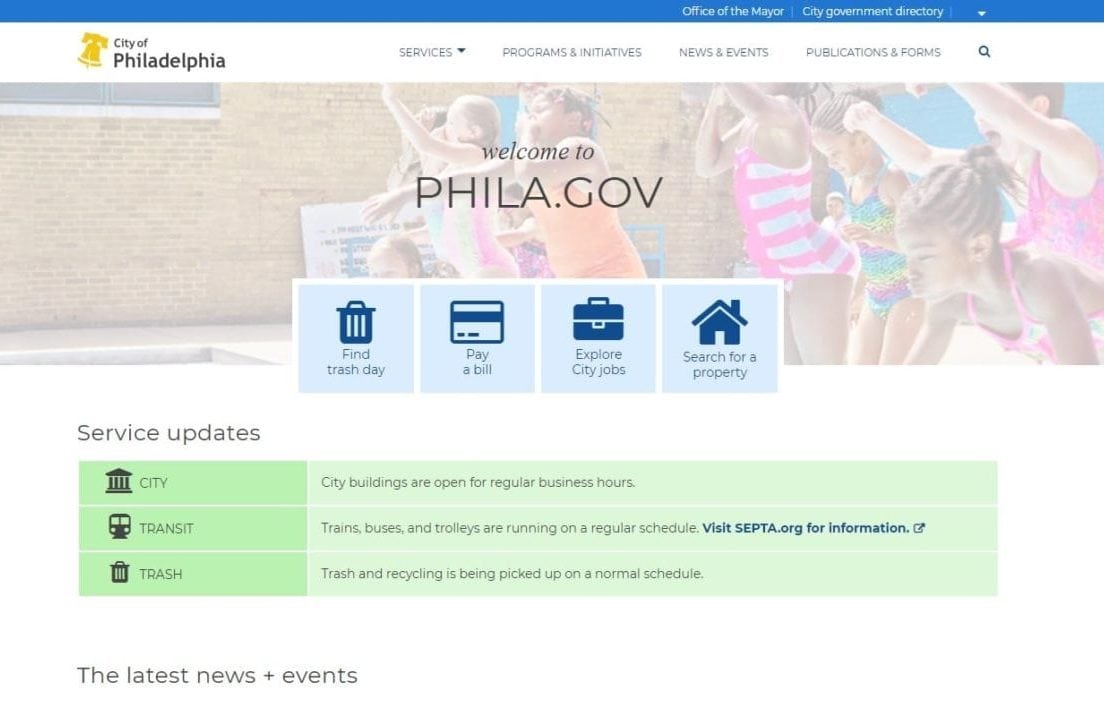A user-centric approach guided the multi-year redesign of Phila.gov, the City of Philadelphia’s website, which officially emerged from beta mode on Tuesday.
As early as December 2014, Philadelphia’s main internet presence went into alpha mode in a push to “redesign the experience customers have interacting with city government online,” then-Chief Innovation Officer Adel Ebeid said.
In October 2016, following a few shifts in management, the city went public with the beta version of the site, which has now evolved into Phila.gov’s official form with leadership from the Office of Data and Digital Transformation (ODDT), which reports to Chief Administrative Officer Christine Derenick-Lopez.
The latest version of the site — which draws around 35,000 to 40,000 unique pageviews per day — features plain-language content, a global menu that officers access to service and improved usability on mobile devices.
“This not a big reveal, but rather a compilation of small reveals,” said Chief Data Officer Tim Wisniewski at the demo of the site on Tuesday morning. “This hasn’t been about a small team of techies swooping in to fix the website, but rather about working together to empower departments and working with colleagues there to ensure that access to content gets better overall.”
Wisniewski is likely referencing some of the early friction in migrating content from departments onto the new website. For Symbol Lai, deputy director of the Office of Immigrant Affairs, if there was any friction it’s now gone: The department worked with the ODDT team to transform its content for Immigrant Heritage Month.
“We are friends now,” Lai said. “They listen to our many needs and we’re working with them again for upcoming events.”
Sara Hall, product director at ODDT, gave a virtual tour of the new site structure and said the site is now a robust platform that hosts some 400 services, 40 programs and an array of publications and forms.
Close to 100 entities (between departments, offices and task forces) have a presence on the online portal. Twenty-five sites are fully migrated, with another 50 or so that have “a solid presence with plenty of representation” and around 30 more — including the Free Library of Philadelphia — simply have a presence and a link to their non-dot-gov site.
For example, the Department of Revenue, which drives around 30 percent of visitors to the site, had already rewritten most of its content for the beta version and is now working on additional resources for citizens.
“The new site gives us greater control,” said Rebecca Lopez-Kriss, the former Deparment of Commerce staffer who is now (inhales) Senior Policy Analyst & Director of Taxpayer and Water Customer Outreach at Revenue. “We’re able to make more engaging content that allows us to help people save money by connecting them with information on programs and assistance.”

But check under the hood and you’ll also find changes to the website: Phila.gov is now a fully-cloud-based site, hosted on Amazon Web Services rather than on city servers.
Tom Swanson, chief enterprise architect for the Office of Innovation and Technology, said developers from his office and ODDT worked together for over two months to migrate the site to a scalable tech infrastructure that can handle spikes in traffic and is protected by with several layers of security.
“It’s even configured using [open source infrastructure tool] Terraform, which we’re super stoked about but is way in the tech weeds,” said Wisniewski in an email.
Wisniewski said people can subscribe to the city’s open source work at its GitHub organization and find things like the Phila.gov WordPress code, the router that handles all its redirects and the Parks and Recreation finder app.
What’s next for the site? The team has plans to decommission all legacy content still live on the site by the end of the year and continue the user experience research to continue to understand how users interact with Phila.gov.
“We’re hoping to continue that for 2019,” Wisniewski said.







